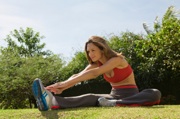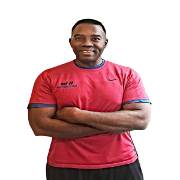 Photo: Getty Images
Photo: Getty Images
Seventy to 80 percent of Americans have back pain (many times low back pain) at some point. Many people develop low back problems because too little time is spent strengthening the muscles of the lower back. Flexibility in the low back area is also a big problem for many.
The sit and reach test measures the flexibility of the lower back and hamstrings.
You will need a box about 12 inches (30 cm) high and a ruler:
1. Sit on the floor with your back and head against a wall. Your legs should be straight ahead and flat against the floor.
2. Place the box flat against your feet (no shoes). Keep your back and head against the wall and stretch your arms out towards the box.
3. Have someone place the ruler on the box and move the zero end towards your fingertips. The beginning measuring point is where the ruler touches your fingertips.
4. Lean forward slowly and smoothly (do not bounce) as far as possible keeping the fingertips level with each other and the legs flat.
5. Slowly reach along the length of the ruler three times. On the third attempt, reach as far as possible and hold for two seconds. Have someone record the score. Do the test two more times to see if you can improve your score.
The American College of Sports Medicine gives the following as good and sub-standard scores:
Men, Ages 20-29
99 Percentile - 23 in (58 cm)
80 Percentile - 20.5 in (52 cm)
50 Percentile - 17.5 in (44 cm)
10 Percentile - 12.25 in (31 cm)
Men, Ages 30-39
99 Percentile - 22 in (56 cm)
80 Percentile - 19.5 in (50 cm)
50 Percentile - 16.5 in (42 cm)
10 Percentile - 11 in (28 cm)
Women, Ages 20-29
99 Percentile - 24 in (61 cm)
80 Percentile - 22.5 in (57 cm)
50 Percentile - 20 in (51 cm)
10 Percentile - 15.5 in (39 cm)
Women, Ages 30-39
99 Percentile - 24 in (61 cm)
80 Percentile - 21.5 in (55 cm)
50 Percentile - 19 in (48 cm)
10 Percentile - 14.5 in (37 cm)
If you fall below the 80 percentile rank, you need to improve your hamstring and lower back flexibility.
Good low back flexibility exercises are double knee-to-chest stretch, pelvic tilt, lower trunk rotation, trunk flexion and prone lumbar extension. Some good hamstring flexibility exercises are walking lunges, resistance band eccentric stretch, bodyweight deadlift and hamstring static stretch (static stretch should be done after workout or game).
Muscle flexibility is just as important as muscle strength. Watch your back!
Mark Dilworth, BA, PES, CPT is a Certified Personal Trainer and former NCAA Division I athlete. Mark’s Fat Blaster Athletic Training System has been proven to give his clients the fit, sculpted and athletic-type bodies they want. Visit Mark’s sites:
My Fitness Hut http://myfitnesshut.blogspot.com
Her Fitness Hut http://herfitnesshut.com
Sports Fitness Hut http://sportsfitnesshut.blogspot.com






Add a CommentComments
There are no comments yet. Be the first one and get the conversation started!